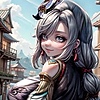HOME | DD
 artbyjpp — Heimdallr
artbyjpp — Heimdallr

#aesir #asatru #bifrost #god #heathen #heimdall #nordic #norse #norsemythology #pagan #scandinavian #vanir #heimdallr #norsepaganism #norsepagan #bilrost #heimdali
Published: 2020-04-08 16:59:09 +0000 UTC; Views: 2576; Favourites: 13; Downloads: 0
Redirect to original
Description
Heimdall (Old Norse Heimdallr, also Heimdalr and Heimdali, perhaps 'the one who illuminates the world'; etymology obscure). A Nordic god, of the Æsir, who is considered to be the guardian of the gods. Heimdall is mentioned several times in the Eddic lays, but only rarely in skaldic poetry (Húsdraápa 10 and a few late stanzas). Nonetheless, he appears to have played a significant role in heathen mythology.
In the Völuspá 1 as well as in the Rígsþula, where he appears under the pseudonym Rígr, Heimdall is said to be the father of all mankind. Heimdall is Loki´s mortal enemy (Lokasenna 48) and both kill each other at Ragnarök (Gylfaginning 50). Snorri tells of Heimdall: ´he is called the white Ás, and he is great and holy; he was born of nine sisters.´He is also known as Hallinskiði and Gullitanni as his teeth are made from gold. His horse is called Gulltropr. He lives at Himinibjörg near (the bridge) Bilröst; he is the gods´watchman and sits at the end of Asgarð guarding the bridge against the mountain Jötnar. He needs less sleep than a bird and can see things 100 miles off whether it is day or night. He can hear the grass growing on the earth and the wool on sheep and everything else which is louder than that. He owns the horn called the Gjallarhorn which can be heard throughout the whole world. Heimdall´s sword is called Höfuð (man-head: Gylfaginning 26). Apart from this mysterious comment which could show that Heimdall himself was killed by a man´s head, there are many other things which are somewhat obscure about this god. The reference to Heimdall being born from nine mothers, all of whom are sisters, could be understood to mean the nine daughters of Ægir, the waves. Elsewhere (Hyndlulijóð 35-37) it is said quite definitely that these nine mothers were Jötunesses, and the names of these nine and the names of Ægir´s daughters do not concur.
Heimdall´s epithet Hallinskiði is used to the Þulur also as a name for a ram, just as heimdali is, although this is otherwise a different form of the name Heimdall. Possibly Heimdall was associated with the ram, just as Þórr with his goats, Freyr with his boar, and Óðin with his ravens or wolves. Much went further and wanted to see Heimdall as a ram-shaped god as the ram was unquestionably a common sacrificial animal among the Germanic peoples (cf. Old Norse sauðr ´sheep´, Gothic sauþs ´sacrifice´) and was perhaps even thought of as a sacred animal.
As the gods´watchman (Grímnismál 13, Lokasenna 48) and guard over the heavenly bridge Bilröst, Heimdall gives a blast on his horn at the beginning of Ragnarök to warn the gods (Völuspá 46; Gylfaginning 50). De Vires concluded from this that Heimdall ought to be listed among the gods of the second mythical function, that of strength, whereby Þórr would represent the warrior and Heimdall the guardsman. Dumézil however thinks of Heimdall as the god of origin, like the Roman Janus and the Indian Dyauh of the Mhabharata, not as the father of the gods, but as the god of the beginning of long life (symbolized by his nine births.) In this case Snorri´s information that Heimdall is Óðin´s son (Skáldskaparmál 8) is inaccurate. Schröder, on the other hand, understands Heimdall to be a god of fire who would correspond to the Indian god Agni.
The role which Heimdall plays in the fight for the Brísigamen (Frejya´s necklace), of which Ulfr tells in his Húsdrápa, is even more obscure. A further puzzle is the meaning of his brilliant appearance in the myth and his golden teeth. Even more mysterious is the reference to Heimdallr´s ear in Völuspá which lies beneath the World-ash (Yggdrasil). Even Heimdall´s epithet Vindlér is obscure in its relationship to the god Heimdall.
Related content
Comments: 4

👍: 1 ⏩: 1

👍: 1 ⏩: 1

👍: 1 ⏩: 0


















